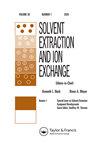D2EHPA/TBP从钒渣碱性浸出液中选择性溶剂萃取铬上钒
IF 2.1
4区 化学
Q3 CHEMISTRY, MULTIDISCIPLINARY
引用次数: 0
摘要
摘要采用磷酸二(2-乙基己基)酯(D2EHPA)和磷酸三正丁酯(TBP)混合萃取剂,提出了一种从铬上选择性萃取钒(IV)的工艺。考察了萃取过程中初始水溶液pH值、浸出液和D2EHPA浓度、相比(O/A)、萃取平衡时间和萃取温度等因素对V、Cr分离的影响。在最佳萃取条件下,钒的萃取率在94.0%以上,同时,在最佳汽提条件下,以1.5mol/L硫酸为有效汽提剂,钒的汽提率在93.0%以上。讨论了汽提后负载有机相的再生和可重复使用性。此外,连续三阶段萃取和汽提策略表明,钒的聚集损失为0.885%,钒的纯度超过99.9%。在最佳沉淀条件下,用氨水将汽提液的pH值调节至7.0时,沉淀效率达到99.93%。通过TG-DTA和TG-MS实验最终确定了煅烧条件(在空气中680°C以上),并通过XRD对煅烧得到的V2O5进行了表征。建立了一种无干扰检测钒基体中杂质元素的方法。该回收技术对扩大生产规模,降低比能耗和成本,实现钒浸出过程的自动化控制具有现实意义。本文章由计算机程序翻译,如有差异,请以英文原文为准。
Selective Solvent Extraction of Vanadium Over Chromium from Alkaline Leaching Solution of Vanadium Slag by D2EHPA/TBP
ABSTRACT A selective extraction process for recovering vanadium (IV) over chromium was proposed with use of a mixed extractant consisting of di(2-ethylhexyl) phosphate (D2EHPA) and tri-n-butyl phosphate (TBP). The influence of various factors, which included the initial aqueous pH value, the concentration of leach solution and D2EHPA, phase ratio (O/A), extraction equilibrium time and extraction temperature in the extraction process on the separation of V and Cr was investigated. Under the condition of the optimum extraction, vanadium extraction was above 94.0%. Meanwhile, under the optimum stripping conditions, the vanadium stripping was above 93.0% utilizing 1.5 mol/L sulfuric acid as the effective stripping reagent. The regeneration and reusability of the loaded organic phases after stripping were discussed. In addition, continuous three-stage extraction and stripping strategy indicated that the aggregate loss of vanadium was 0.885% and that the purity of vanadium was more than 99.9%. Under the condition of the optimum precipitation, when the pH value of the stripping solution was adjusted to 7.0 with ammonia water, the precipitation efficiency reached 99.93%. The calcination conditions (above 680 °C in air) were finally determined by TG-DTA and TG-MS experiments, and the V2O5 obtained by calcination was characterized by XRD. Additionally, a method for detecting impurity elements in vanadium matrix without interference was established. The recovery technology has practical significance in enlarging production scale, reducing specific energy consumption and cost, and realizing automatic control in vanadium leaching process.
求助全文
通过发布文献求助,成功后即可免费获取论文全文。
去求助
来源期刊
CiteScore
4.40
自引率
5.00%
发文量
15
审稿时长
8.4 months
期刊介绍:
Solvent Extraction and Ion Exchange is an international journal that publishes original research papers, reviews, and notes that address all aspects of solvent extraction, ion exchange, and closely related methods involving, for example, liquid membranes, extraction chromatography, supercritical fluids, ionic liquids, microfluidics, and adsorption. We welcome submissions that look at: The underlying principles in solvent extraction and ion exchange; Solvent extraction and ion exchange process development; New materials or reagents, their syntheses and properties; Computational methods of molecular design and simulation; Advances in equipment, fluid dynamics, and engineering; Interfacial phenomena, kinetics, and coalescence; Spectroscopic and diffraction analysis of structure and dynamics; Host-guest chemistry, ion receptors, and molecular recognition.

 求助内容:
求助内容: 应助结果提醒方式:
应助结果提醒方式:


